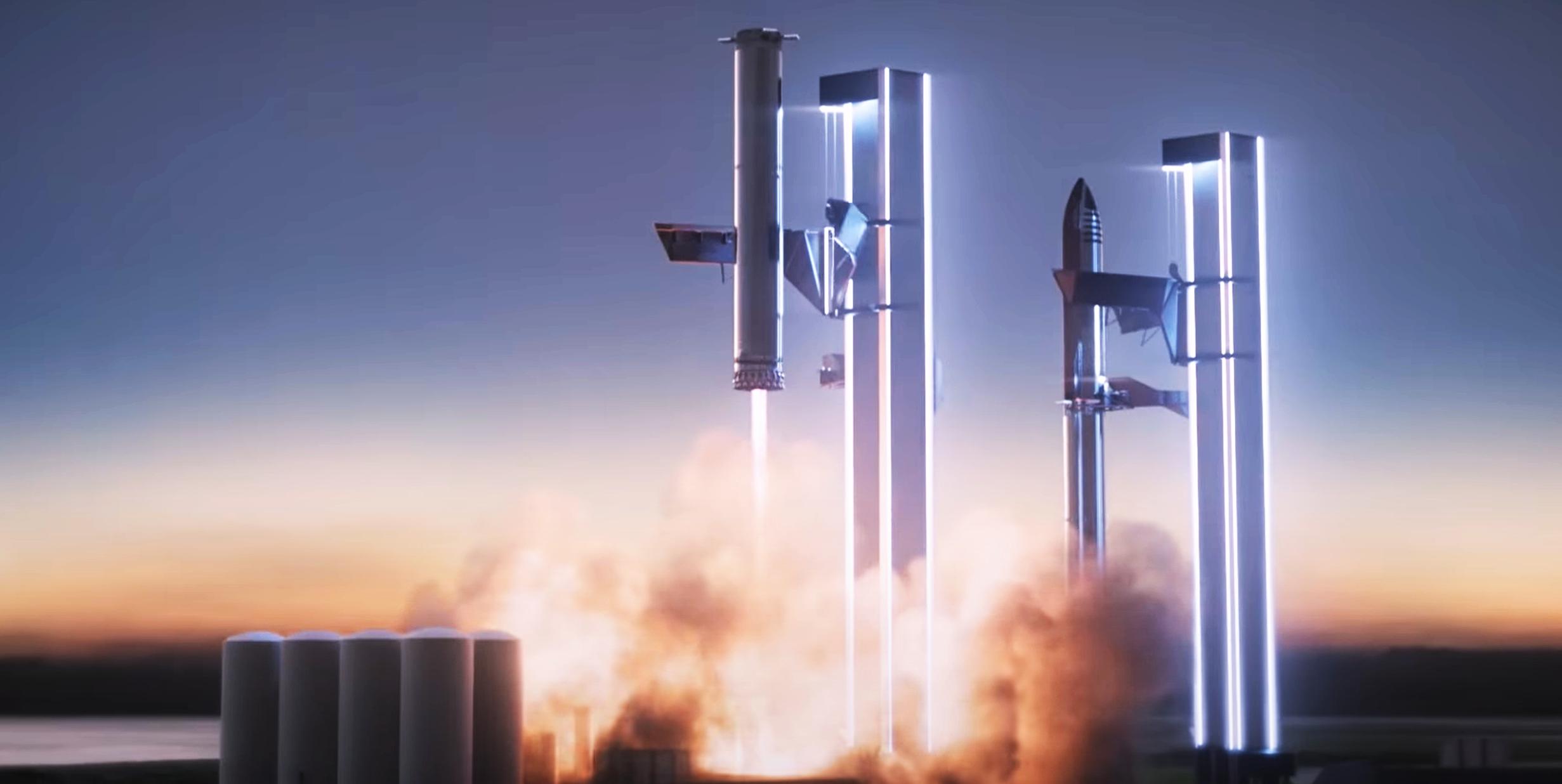
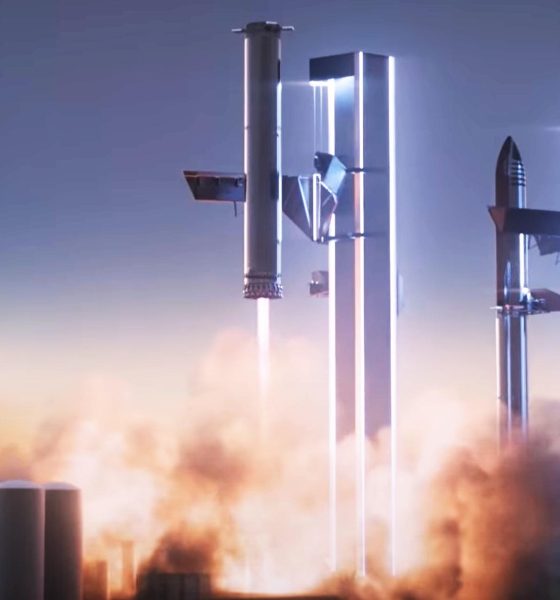
News
SpaceX wants to attempt Starship booster catch during first orbital launch
An updated document submitted by SpaceX to the US Federal Communications Commission (FCC) has revealed details about the company’s plan for the first Starship booster ‘catch’ attempt.
The document follows a different batch submitted by SpaceX in June 2021, when the company detailed its plans for Starship’s orbital launch debut as background while requesting permission from the FCC to use Starlink dishes for in-flight telemetry. A month earlier, a different request focused on more standard telemetry antennas had already revealed that even if the mission went perfectly, Starship would not fully reach orbit on its first attempted spaceflight. It also confirmed that SpaceX had no intention of recovering the upper stage or Super Heavy booster assigned to Starship’s launch debut – a sort of implicit acknowledgment that success was (then) not expected on the first try.
Twelve months later, SpaceX has submitted an updated overview of Starship’s orbital launch debut in a new request for permission to use multiple Starlink dishes on both stages. While most of the document is the same, a few particular details have changed about Super Heavy’s role in the mission.
This time around, SpaceX says that the Super Heavy booster will “will separate[,] perform a partial return[,] and land in the Gulf of Mexico or return to Starbase and be caught by the launch tower.” Prior to this document, SpaceX’s best-case plans for the first Super Heavy booster to launch never strayed from a controlled splashdown in the Gulf of Mexico – potentially demonstrating that it would be safe to attempt booster recovery on the next launch but all but guaranteeing that the first booster would be lost at sea.
A year later, SpaceX appears to be a bit more confident and wants to leave itself the option to attempt to recover the first Super Heavy booster that launches. However, the company has dramatically complicated the process of testing early Super Heavy and Starship recovery (and thus reuse) by fully removing traditional and predictable landing legs and designing its latest prototypes such that the only way they can be recovered in one piece is with a giant mechanized ‘launch tower’ nicknamed Mechazilla.
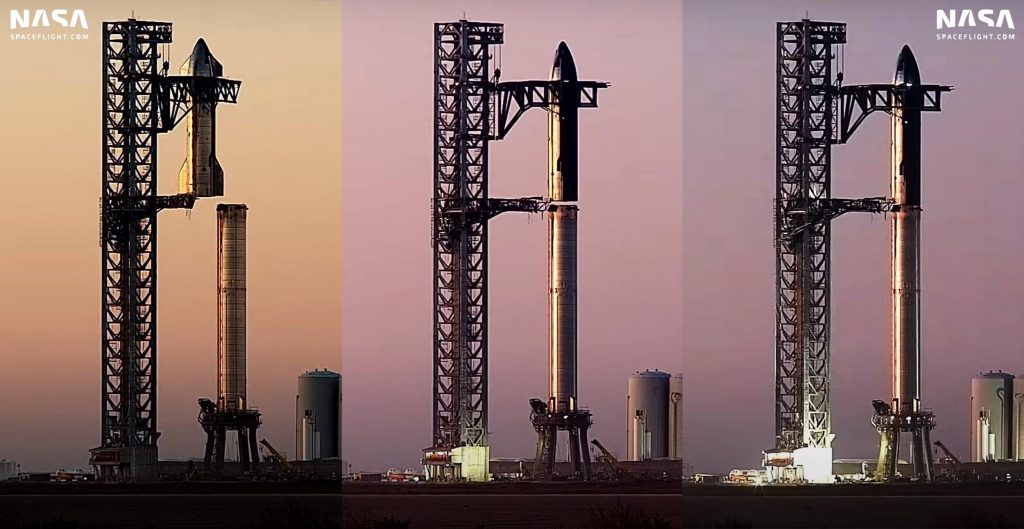
The launch tower and its three mobile arms will play a crucial role in all aspects of orbital Starship launches. The first arm swings out to brace Super Heavy for Starship installation and connect the upper stage to power, propellant supplies, and other launch pad utilities. A more exotic pair of arms nicknamed ‘chopsticks’ has a more complex job. On top of using the chopsticks to lift, stack, and demate Starships and Super Heavy boosters and almost any weather and wind conditions, SpaceX wants to use the arms as an incredibly complex and precarious rocket recovery system.
For a booster or Starship “catch,” the rocket will approach the tower, enter the gap between the splayed arms, hover in place while the arms close around it, and eventually come to rest on hardpoints that appear to offer about as much surface area as a coffee table. Based on a simulation of the process shown by Elon Musk, calling it a “catch” is a misnomer, as the arms will mainly move in one dimension (open/close) and can’t actually ‘grab’ the rocket in any real sense. As built and shown, they are closer to a tiny fixed landing platform capable of minor last-second positional adjustments.
Eventually, the chopsticks could shave a small amount of time off of post-recovery processing, removing the need for a crane (or the same arms) to attach to a landed booster or ship. They could also shave off the dry mass required for landing legs, though all interplanetary ships will still need legs. However, they will also inherently make proving their own efficacy a nightmare. By all appearances, the current recovery mechanisms on the arms and the landing hardpoints on ships and boosters mean that a ‘catch’ could fail if either stage is more than a foot or two from a perfect bullseye or rotated a few degrees in the wrong direction. With the method SpaceX has devised, even the tiniest error could easily end with a massive, pressurized, partially-fueled rocket destroying the chopsticks and plummeting a few hundred feet to the ground, guaranteeing an explosion that could damage surrounding infrastructure or start fires that might.
In the event of larger anomalies during a landing attempt, Starship or Super Heavy could accidentally impact the launch tower, damaging or even outright destroying the skyscraper-sized structure. Ultimately, the immense risk posed by any catch attempt means that unless SpaceX has miraculously gotten the design of everything involved nearly perfect on its first try, the company will have to be extraordinarily cautious and expend a large number of ships and boosters to avoid rendering its only Starship launch tower unusable.
At least to some extent, SpaceX likely knows this and Super Heavy would likely need to be in excellent health and perform perfectly during the ascent and boostback portions of its launch debut to be cleared for a catch attempt. Ultimately, Starship’s first orbital launch could end up being even more of a spectacle than it’s already guaranteed to be.

Cybertruck
Tesla updates Cybertruck owners about key Powershare feature

Tesla is updating Cybertruck owners on its timeline of a massive feature that has yet to ship: Powershare with Powerwall.
Powershare is a bidirectional charging feature exclusive to Cybertruck, which allows the vehicle’s battery to act as a portable power source for homes, appliances, tools, other EVs, and more. It was announced in late 2023 as part of Tesla’s push into vehicle-to-everything energy sharing, and acting as a giant portable charger is the main advantage, as it can provide backup power during outages.
Cybertruck’s Powershare system supports both vehicle-to-load (V2L) and vehicle-to-home (V2H), making it flexible and well-rounded for a variety of applications.
However, even though the feature was promised with Cybertruck, it has yet to be shipped to vehicles. Tesla communicated with owners through email recently regarding Powershare with Powerwall, which essentially has the pickup act as an extended battery.
Powerwall discharge would be prioritized before tapping into the truck’s larger pack.
However, Tesla is still working on getting the feature out to owners, an email said:
“We’re writing to let you know that the Powershare with Powerwall feature is still in development and is now scheduled for release in mid-2026.
This new release date gives us additional time to design and test this feature, ensuring its ability to communicate and optimize energy sharing between your vehicle and many configurations and generations of Powerwall. We are also using this time to develop additional Powershare features that will help us continue to accelerate the world’s transition to sustainable energy.”
Owners have expressed some real disappointment in Tesla’s continuous delays in releasing the feature, as it was expected to be released by late 2024, but now has been pushed back several times to mid-2026, according to the email.
Foundation Series Cybertruck buyers paid extra, expecting the feature to be rolled out with their vehicle upon pickup.
Cybertruck’s Lead Engineer, Wes Morrill, even commented on the holdup:
As a Cybertruck owner who also has Powerwall, I empathize with the disappointed comments.
To their credit, the team has delivered powershare functionality to Cybertruck customers who otherwise have no backup with development of the powershare gateway. As well as those with solar…
— Wes (@wmorrill3) December 12, 2025
He said that “it turned out to be much harder than anticipated to make powershare work seamlessly with existing Powerwalls through existing wall connectors. Two grid-forming devices need to negotiate who will form and who will follow, depending on the state of charge of each, and they need to do this without a network and through multiple generations of hardware, and test and validate this process through rigorous certifications to ensure grid safety.”
It’s nice to see the transparency, but it is justified for some Cybertruck owners to feel like they’ve been bait-and-switched.
News
Tesla’s northernmost Supercharger in North America opens
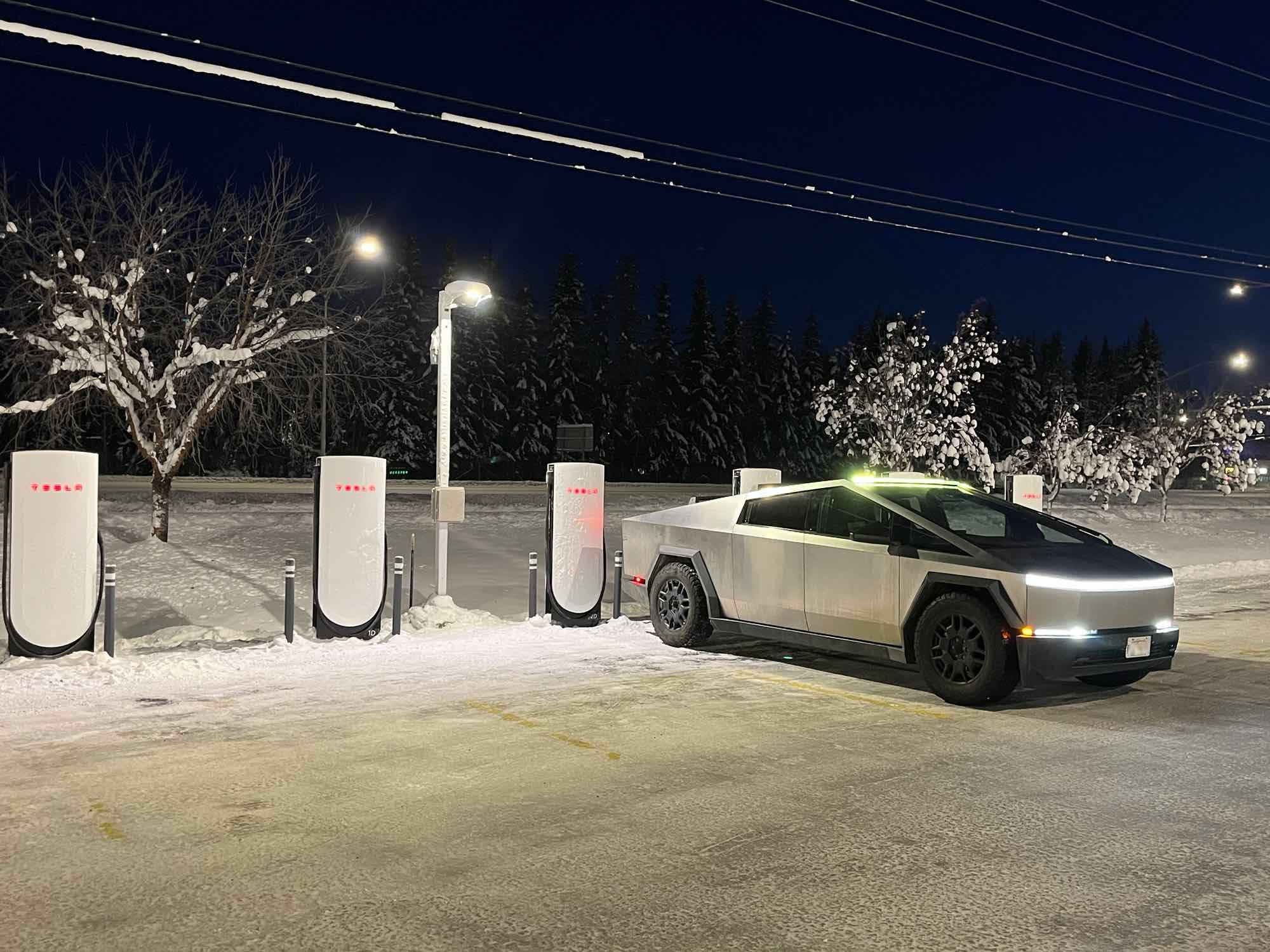
Tesla has opened its northernmost Supercharger in Fairbanks, Alaska, with eight V4 stalls located in one of the most frigid cities in the U.S.
Located just 196 miles from the Arctic Circle, Fairbanks’s average temperature for the week was around -12 degrees Fahrenheit. However, there are plenty of Tesla owners in Alaska who have been waiting for more charging options out in public.
There are only 36 total Supercharger stalls in Alaska, despite being the largest state in the U.S.
Eight Superchargers were added to Fairbanks, which will eventually be a 48-stall station. Tesla announced its activation today:
North America’s northernmost Supercharger Fairbanks, AK (8 stalls) opened to public. https://t.co/M4l04DZ6B5 pic.twitter.com/zyL6bDuA93
— Tesla Charging (@TeslaCharging) December 12, 2025
The base price per kWh is $0.43 at the Fairbanks Supercharger. Thanks to its V4 capabilities, it can charge at speeds up to 325 kW.
Despite being the northernmost Supercharger in North America, it is not even in the Top 5 northernmost Superchargers globally, because Alaska is south of Norway. The northernmost Supercharger is in Honningsvåg, Norway. All of the Top 5 are in the Scandanavian country.
Tesla’s Supercharger expansion in 2025 has been impressive, and although it experienced some early-quarter slowdowns due to V3-to-V4 hardware transitions, it has been the company’s strongest year for deployments.
🚨🚨 Tesla Supercharging had a HUGE year, and they deserve to be recognized.
🍔 Opened Tesla Diner, a drive-in movie theater with awesome, Chef-curated cuisine
🔌 Gave access to Superchargers to several EV makers, including Hyundai, Genesis, Mercedes-Benz, Kia, Lucid, Toyota,… pic.twitter.com/yYT2QEbqoW
— TESLARATI (@Teslarati) December 10, 2025
Through the three quarters of 2025, the company has added 7,753 stations and 73,817 stalls across the world, a 16 percent increase in stations and an 18 percent increase in stalls compared to last year.
Tesla is on track to add over 12,000 stalls for the full year, achieving an average of one new stall every hour, an impressive statistic.
Recently, the company wrapped up construction at its Supercharger Oasis in Lost Hills, California, a 168-stall Supercharger that Tesla Solar Panels completely power. It is the largest Supercharger in the world.
News
Tesla shocks with latest Robotaxi testing move
Why Tesla has chosen to use a couple of Model S units must have a reason; the company is calculated in its engineering and data collection efforts, so this is definitely more than “we just felt like giving our drivers a change of scenery.”
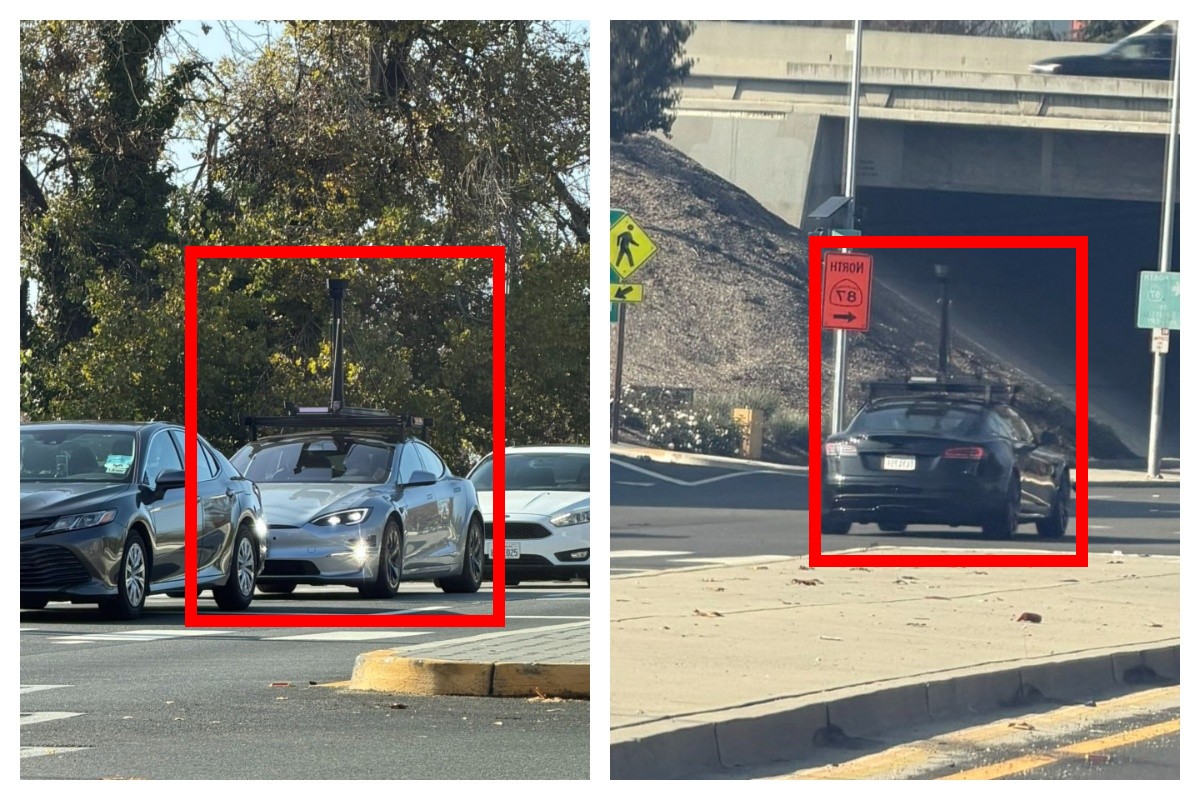
Tesla Model S vehicles were spotted performing validation testing with LiDAR rigs in California today, a pretty big switch-up compared to what we are used to seeing on the roads.
Tesla utilizes the Model Y crossover for its Robotaxi fleet. It is adequately sized, the most popular vehicle in its lineup, and is suitable for a wide variety of applications. It provides enough luxury for a single rider, but enough room for several passengers, if needed.
However, the testing has seemingly expanded to one of Tesla’s premium flagship offerings, as the Model S was spotted with the validation equipment that is seen entirely with Model Y vehicles. We have written several articles on Robotaxi testing mules being spotted across the United States, but this is a first:
🚨 Tesla is using Model S vehicles fitted with LiDAR rigs to validate FSD and Robotaxi, differing from the Model Ys that it uses typically
Those Model Y vehicles have been on the East Coast for some time. These Model S cars were spotted in California https://t.co/CN9Bw5Wma8 pic.twitter.com/UE55hx5mdd
— TESLARATI (@Teslarati) December 11, 2025
Why Tesla has chosen to use a couple of Model S units must have a reason; the company is calculated in its engineering and data collection efforts, so this is definitely more than “we just felt like giving our drivers a change of scenery.”
It seems to hint that Tesla could add a premium, more luxury offering to its Robotaxi platform eventually. Think about it: Uber has Uber Black, Lyft has Lyft Black. These vehicles and services are associated with a more premium cost as they combine luxury models with more catered transportation options.
Tesla could be testing the waters here, and it could be thinking of adding the Model S to its fleet of ride-hailing vehicles.
Reluctant to remove the Model S from its production plans completely despite its low volume contributions to the overall mission of transitioning the world to sustainable energy, the flagship sedan has always meant something. CEO Elon Musk referred to it, along with its sibling Model X, as continuing on production lines due to “sentimental reasons.”
However, its purpose might have been expanded to justify keeping it around, and why not? It is a cozy, premium offering, and it would be great for those who want a little more luxury and are willing to pay a few extra dollars.
Of course, none of this is even close to confirmed. However, it is reasonable to speculate that the Model S could be a potential addition to the Robotaxi fleet. It’s capable of all the same things the Model Y is, but with more luxuriousness, and it could be the perfect addition to the futuristic fleet.








